Sharples P&H
Pretty much all that’s left in Sharples Alberta is an old grain elevator. The location here is a wide shallow valley, scenic, sort of unprairie-like and home to a meandering creek – a nice nice setting! The building is abandoned and while rough-looking and weather worn it has a certain majesty about it. It’s easily one of the more photogenic elevators we’ve yet to explore and we’ve seen our share.
Sharples was founded around 1921-1922, springing to life with the coming of the railway. There was never that much here however, a couple dwellings, some farms in the area, perhaps a store/post office (suggested, but unproven) and not one, but two grain elevators. No metropolis here!
Yes, the place was that small. The road in is gravel and always has been. On maps, of all the dots used that are descriptive of a town’s population, it afforded only the smallest one (so hamlet sized). On the CPR it was a flag stop, meaning there was no depot and any trains offering passenger accommodations would only stop here if requested or on demand. Otherwise they’d pass right on by. One dwelling here remained lived in into the 1980s or thereabouts, a home to the last resident or residents. Remains of that old dwelling can be seen opposite the elevator.
The track was the Canadian Pacific Railway’s Langdon Alberta to East Coulee line, built mainly to tap the coal reserves in the Red Deer River valley. It was the company’s Langdon Subdivision. Of course, grain was hauled as well. When coal markets dried up in the late 1970s/early 1980s (it was in steep decline since the 1950s) the eastern section through Sharples was closed down at that time. The western section held on until the mid-1990s.
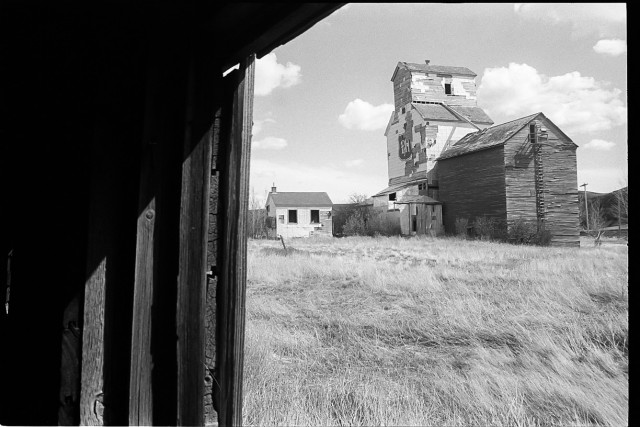
The last grain elevator in Sharples Alberta (shot on film).
Remnants of the former line remain, cuts, fills, the raised roadbed, old poles and the like. At one creek crossing near the elevator, the concrete piers of a bridge can be seen.
The elevator was built in 1923 for Parish and Heimbecker. This grain handling firm dates from around 1909 and is still in business, and while never that huge when compared to rivals, they still had a good-sized network of elevators across the prairie provinces. The old “P&H” logos can still be seen.
The building has a capacity of 28000 bushels, a pretty typical size for the time. In the 1940s two annexes were added, as a way to increase capacity and this more than doubled how much grain could be stored here. One of these remains behind. The other was taken out, date unknown, with only the foundation and a loading pipe suspended mid-air that formerly lead to it, to remind us it was ever here.
Closed in the 1980s (reports differ, some say 1982, some 1984), sort of concurrent with the end of the railway line, the elevator was not torn down as was normal and expected when this happened. It’s suggested a local farmer put it to use storing grain for a time which I guess explains why it was not demolished (lots of old elevators survived this way). It’s been abandoned, however, for many, many years now.
While it looks rough and tattered, mostly due to all the cladding falling off (they were a fire deterrent), structurally it’s probably fine, thanks the usual laid-flat 2×6 wood framing used and heavy concrete or stone foundation, which together makes them near indestructible.
It’s one of the about two hundred and fifty original style wood grain elevators left in the province. In times past, there was over seventeen hundred! All towns on the Alberta plains (a lot), with rail service (again, a lot) had one or more of these structures. This one, I understand, is pretty much as built and is mechanically complete or mostly so. The only change over time was replacing the original gas power plant with an electric motor (around 1950). The former office, a separate building, remains in place.
What’s will happen from here is not known. Abandoned buildings rarely make it out alive. It’s listed as historically recognized, but that doesn’t necessarily mean anything. The government sponsored department that overseen things like this has some powers, but can’t stop a building from deteriorating. If you visit Sharples please be respectful of its historic significance. Take only photos.
There used to be a second elevator in Sharples. This one was built in 1927, for the firm Alberta Pacific Grain, a company with a fair number of elevators across the province. Almost immediately, and for reasons not known, the building soon came under control of the Alberta Wheat Pool, a farmer owned co-op and for much of its existence the largest grain handling firm in the province. They kept it open at least until around the time the railway closed and tore it down soon after.
Seen in the one photo is the “Sharples” phone. In the 1990s this author was driving truck and made a pipe delivery to a nearby gas pant when it was spotted in a ditch along the side of the road not far from the elevator. The number on the dial comes up in a 1970s phone book for the immediate area so we know it’s from Sharples.
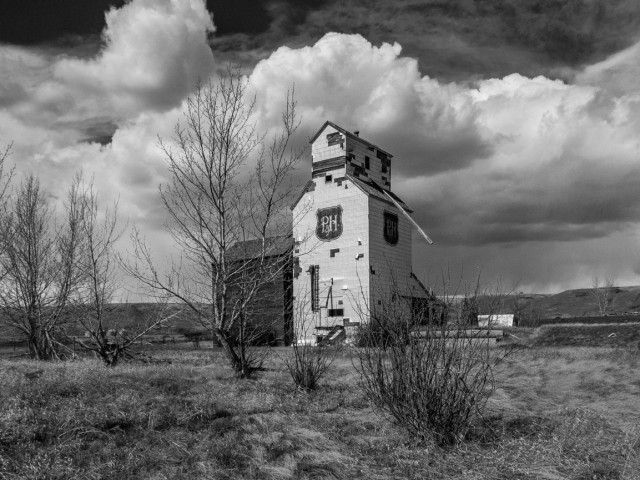
The structure dates from the 1920s.
This old timer of a rotary phone (ITT model NE500) was cleaned up and rewired and is put to use at BIGDoer.com HQ. Yes, we use it. As I often say, the ringer will wake the dead. Brrrriiinnng! Brrrriiinnng! Heck the neighbour knows when we get a call. It’s an AGT phone (Alberta Government Telephones, a dissolved monopoly), so we felt it was perfect placing it on an old marked AGT line box just down from the elevator, for a our photo-op. A perfect home-coming!
By the way, the phone is marked property of AGT. Back then you only leased a phone, residential lines anyway, and NEVER owned it. For a joke I called Telus, who by legacy is most closely related to AGT, just to see if they wanted it back. Once they quit laughing, which took some time, they said we could keep it. Nice of them to make an exception! BTW, if you ask Telus, they may tell you outright that rotary phones will not work on their landline system. They do.
The first photo in this series was shot on film. Every now and then, for fun and excitement, maybe because we love variety and are perhaps a bit crazy, we break out the old Minolta, especially when hanging with noted film photographer Robert Pohl, who we accompanied this day. It’s a whole different world, pure and honest. Things just seem to sloooow down when you have to think and ponder each and every shot. Still, this was the only film shot we were happy with from our Sharples shoot. Damn us and our bad focusing skills! Glasses, use the glasses!
Love grain elevators?
Prairie Sentinels – Mossleigh Alberta.
Prairie Sentinels – Harris Saskatchewan.
Meeting Creek station and elevators.
If you wish more information on what you’ve seen here, by all means contact us!
Date: May, 2015.
Location: Sharples, AB.
Article references: Book: Carbon – our history, our heritage, CPR archives and records @ Exporail in Quebec, Alberta Pool records.
Please show this site respect and take only photos.
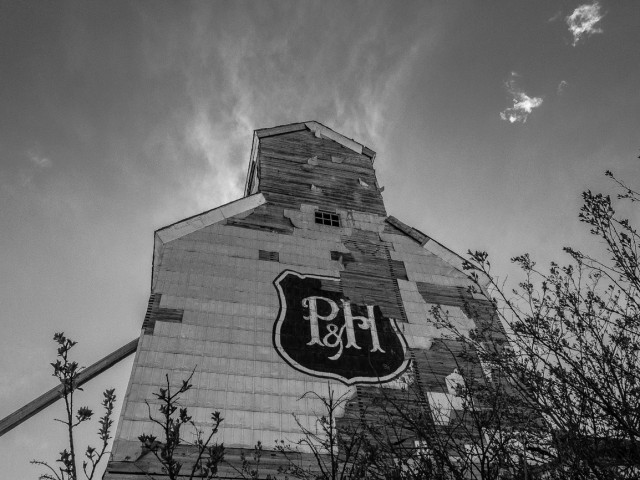
P&H = Parrish and Heimbecker, its one time owner.
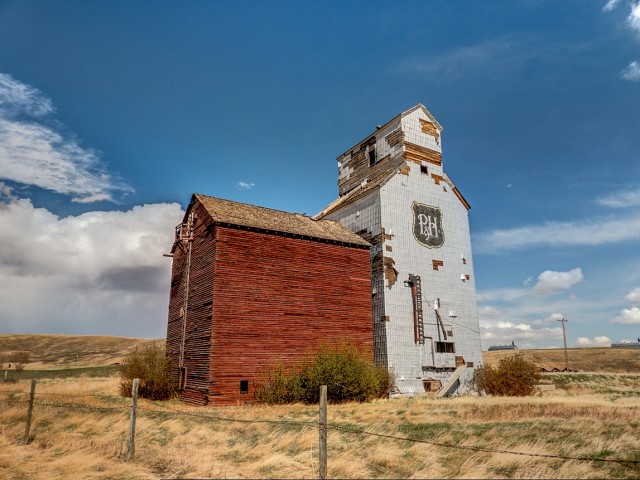
The facility closed in the 1980s.
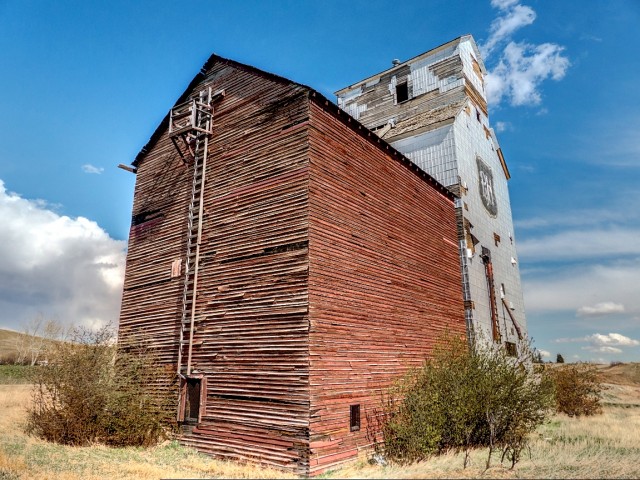
A large annex on the west side.
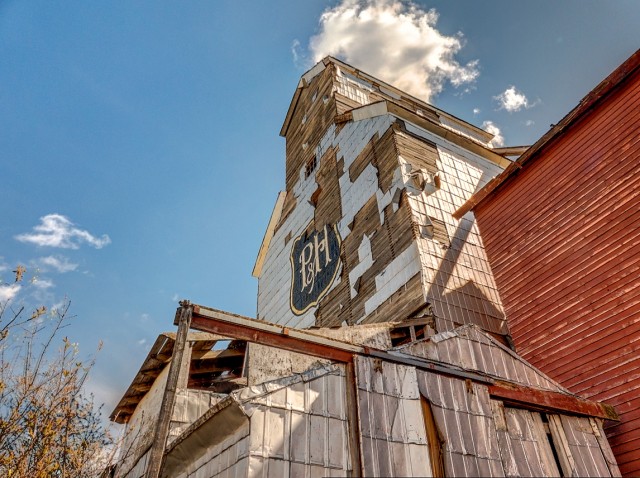
The metal cladding is peeling away.
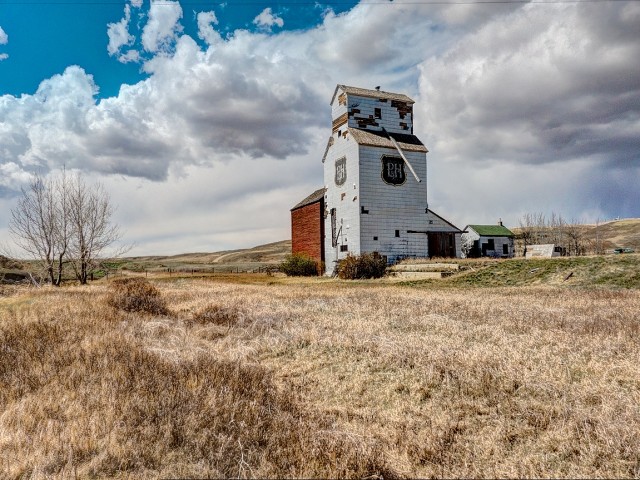
The flat area in front is where the rail line and elevator siding were once located.
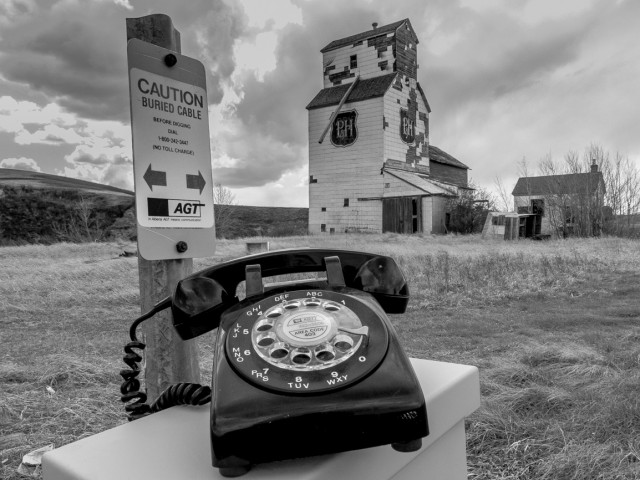
The “Sharples” phone comes home.
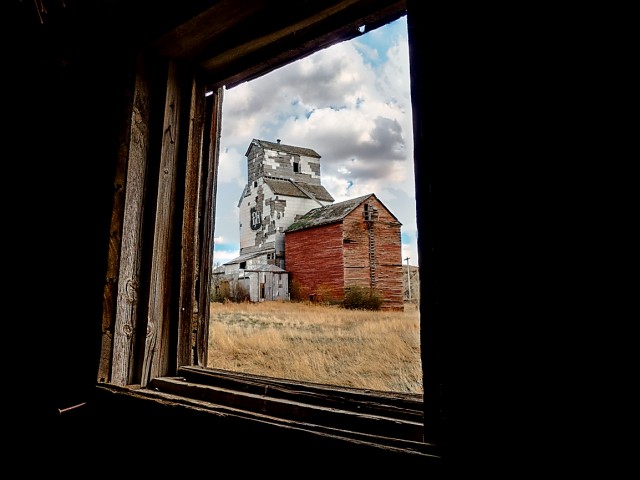
A parting glance…

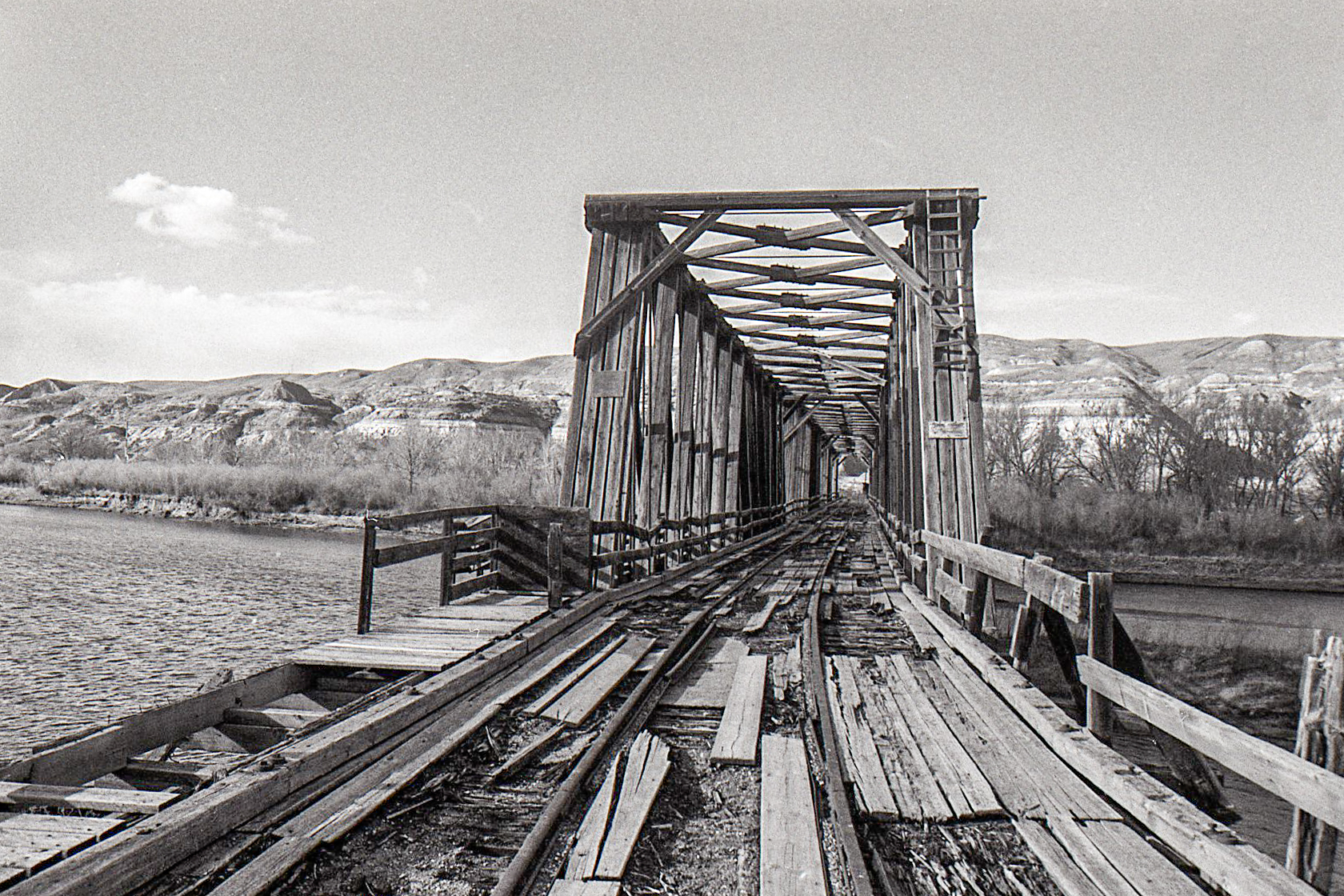
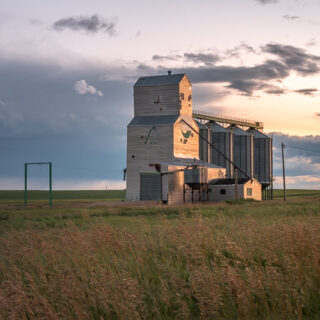
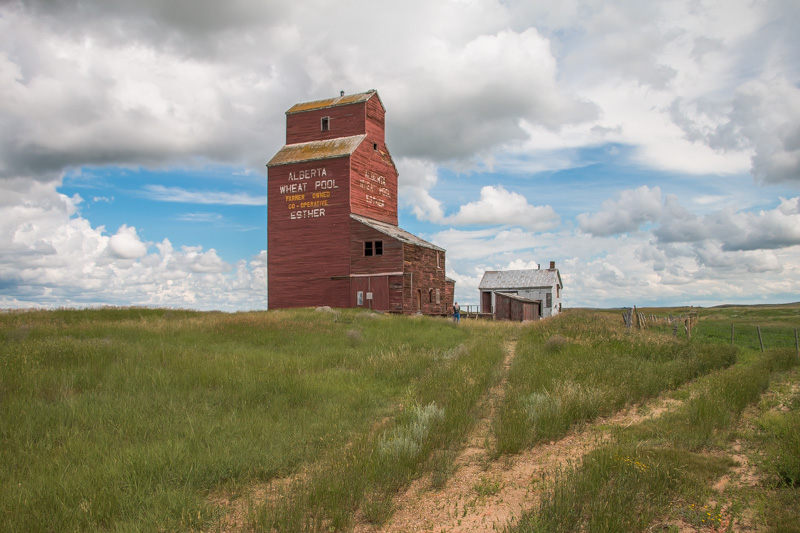
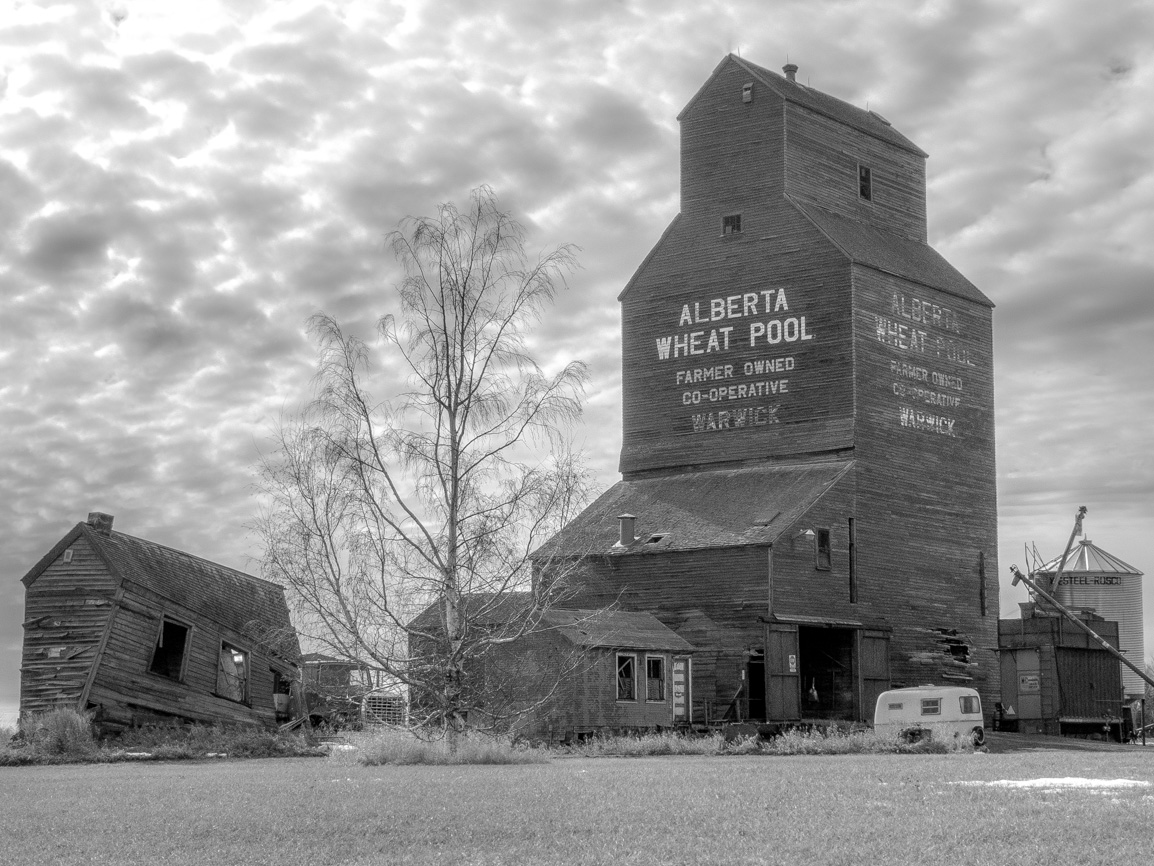
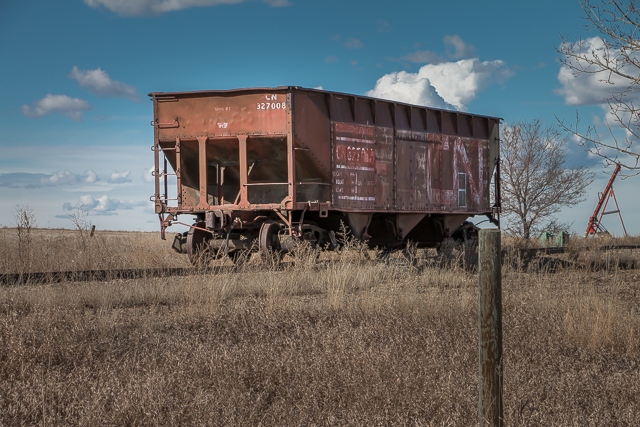
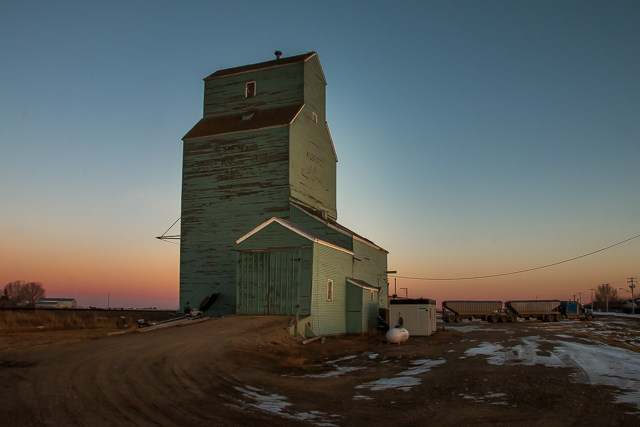
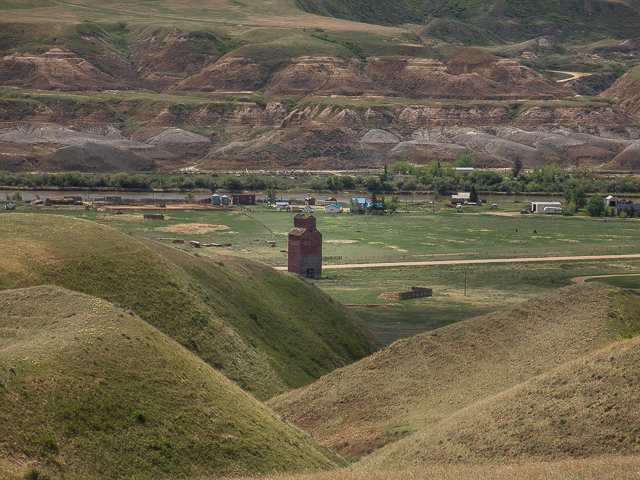
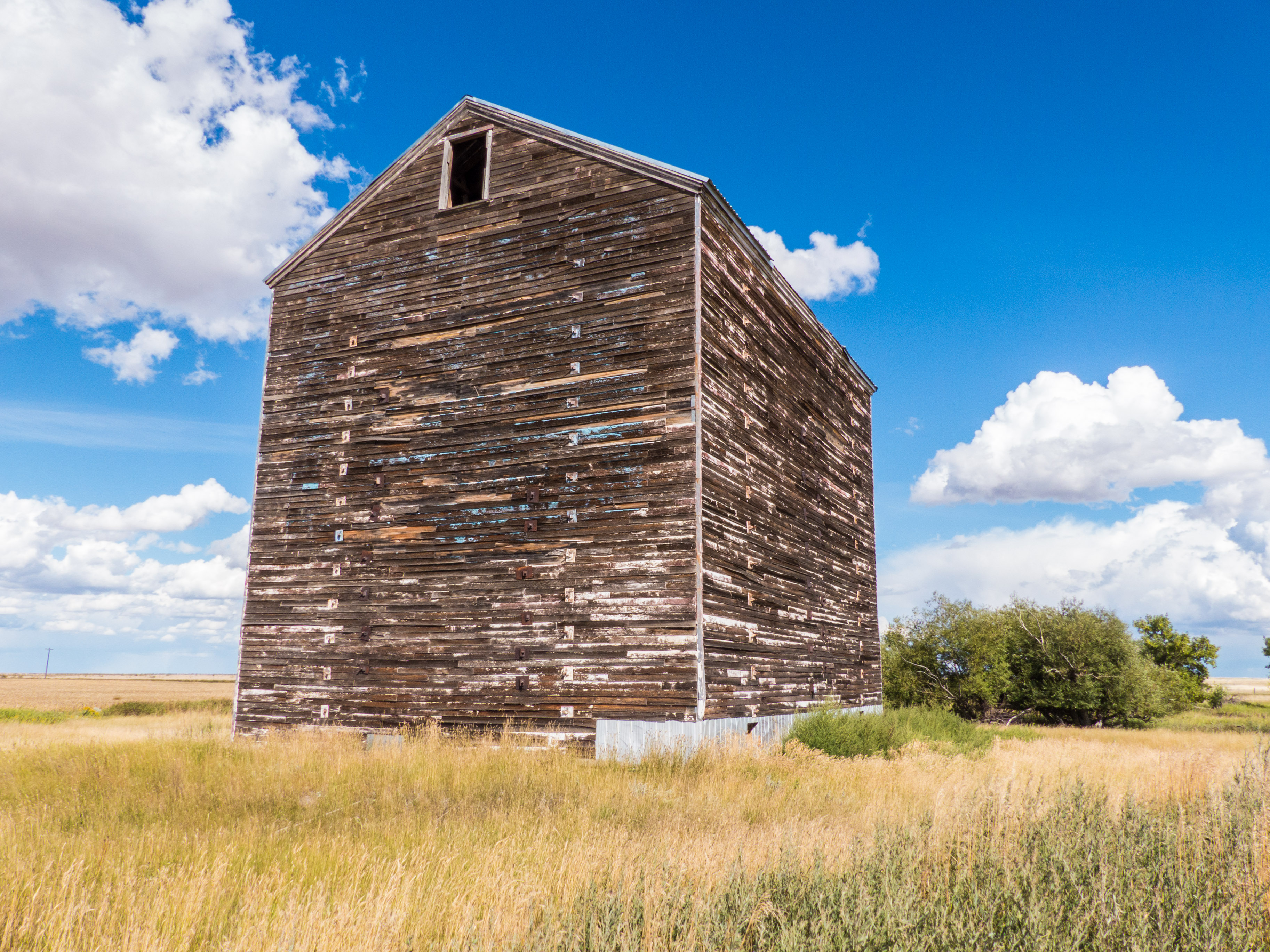
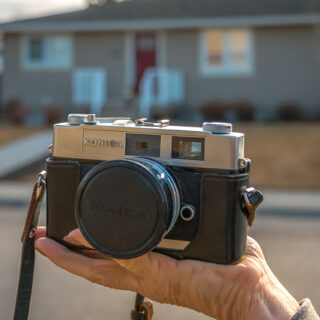
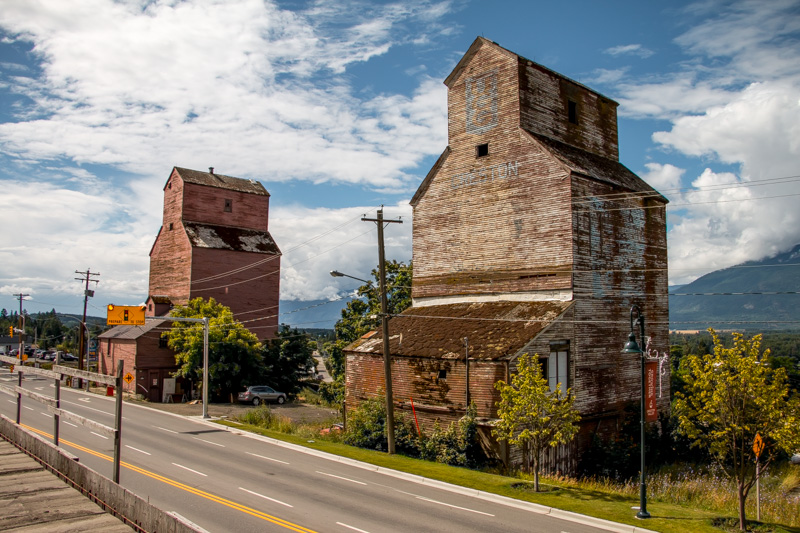
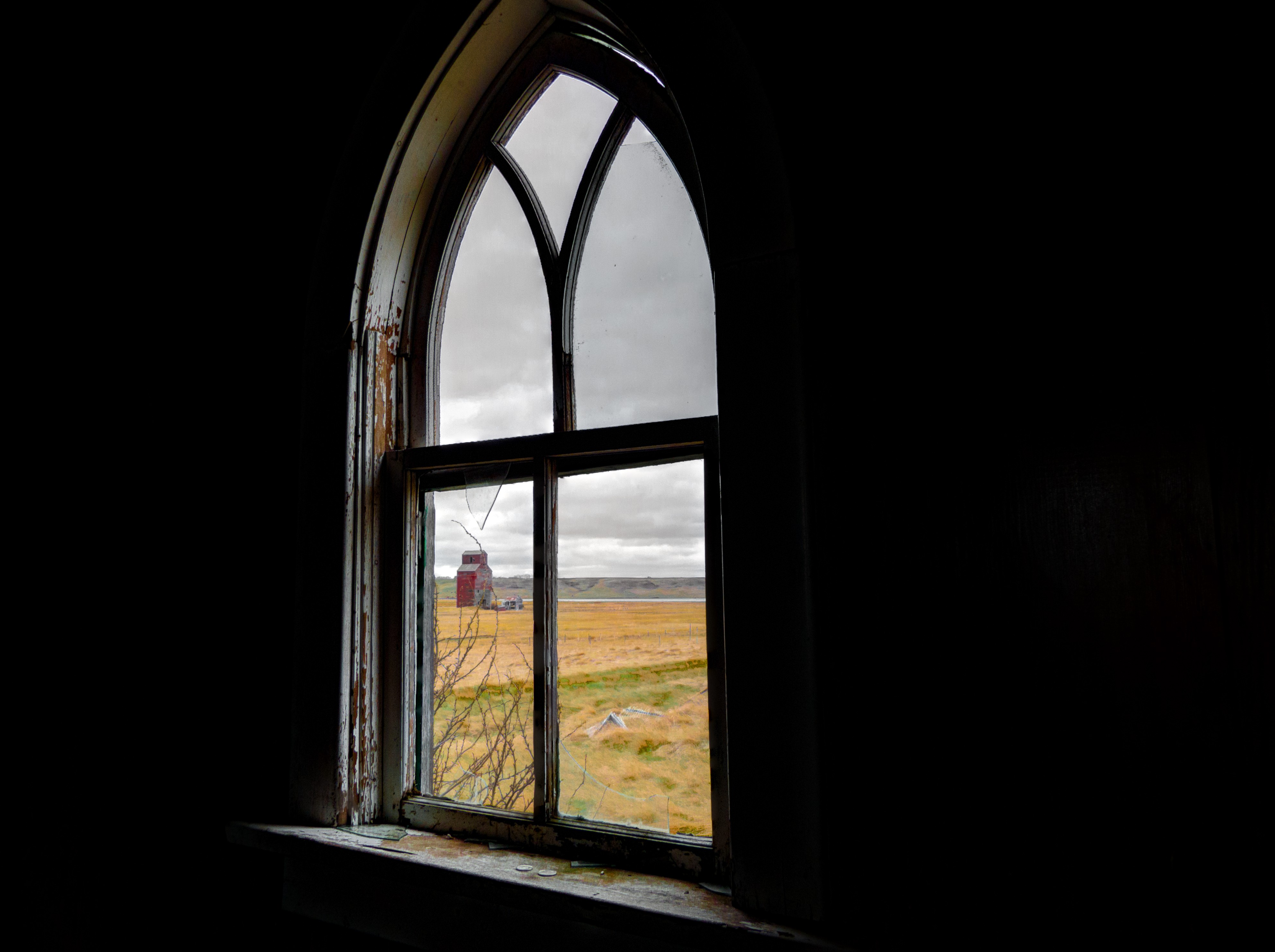
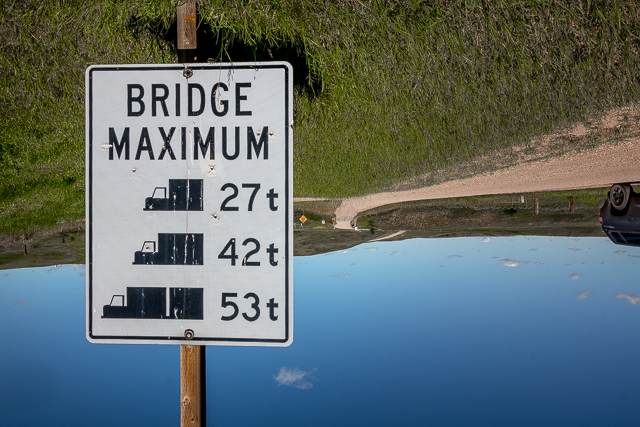
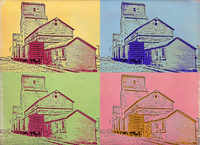






I’ve got one of those black rotary phones too ☺ Drove past Sharples road on my way back from the museum yesterday – now maybe I’ll stop in to see the elevator next time I’m in the area.
Those old phones are so iconic! The Sharples elevator is a treasure and always worth a stop to look at. It loves to be in photos.
Hi Chris and Connie
Thought you might be interested to learn why the elevator is called Sharples. It was named after my great uncle John Sharples, from Rishton, near Blackburn, England.
He and his brother James went to work for the Canadian Pacific Railway in about 1908. He fought in World War I with the 1st Battalion Canadian Machine Gun Corps at Vimy Ridge in France. He was awarded the Distinguished Conduct Medal for single handedly holding his position against the Germans for 7 hrs after all his comrades had been killed.
In honour of this, Canadian Pacific Railway named the grain elevator after him. Jim Pearson, who has compiled “Vanishing Sentinels” kindly sent me a 3D cardboard model of the elevator a few years ago. I have lots of account bills from Parrish & Heimbecker which were found in the elevator.
My partner is at this very moment visiting The Somme area and northern France, including Vimy, and has been to visit the Canadian National Vimy Memorial there.
I’m sure lots of grain elevators have similarly interesting histories!
Regards, Vivian Downing
So nice to hear from you Vivian. Interesting connection! I could see why he was bestowed the honour of having the place named after him given his exemplary service to country. Just a small clarification. The elevator was not named Sharples but rather reflects the name of the loading point or “town” here. I assume you already know that. Thanks a million for commenting!
Hi Chris
I take your point about it being the area which is Sharples, rather than the building. The 3D model I was sent has Sharples printed on it, but this is probably “artistic licence” or just a means of labelling the model.
The elevator is a majestic and atmospheric looking building now.
Regards, Vivian Downing
Vivian, that it has Sharples written on it is correct from an historical context. Elevators, traditionally, always had the community name on their sides. Browse BIGDoer.com and see. For elevators not in company use or abandoned (so most) they may be painted over or faded out, but rest assured they were there.
Hi
Just looking into my family tree that my daughter Stephanie has been researching. I am James grandson and live near Blackburn in England. My father who was James son and James used to tell me tales of the experience that James had on the railway, less so about the experience during the war, although I have gained a lot of information about this. I did meet John a number of times when he visited my grandfather on hi farm in the 60’s possibly early 70’s.
Interesting, that’s so very cool! You’re connected to the place, which is magic. So very good to hear from you and thanks for adding to the story.
I didn’t know anything about Sharples but saw the name and took a detour off Hwy 21. As we came down the dirt road around that bend and the elevator came into view, I gasped. I was so excited. I looked it up after and found your story and photos. Love it!!
It’s a special place, so photogenic. Thanks for commenting!
Nice photo set and story of Sharples Alberta ,one of my favorite places to photograph.
It always looks so nice there in spring with the green grass.
You would of Jumped if that phone would of Rung 😉
As always thanks for sharing.
I love going back. It’s the first time for the Sharples phone however.
I wonder how many kids today would know how to dial one of those phones?
I can say with strong certainty, very few. Our kids do (did) but they grew up with some.
We have soooo much fun doing this, and it’s more fun with friends!
Spot on, it’s more fum to collaborate.
I love your photography!
And we love you comment. We do enjoy what we do!
Shared to Ghost Town Hunters.
Mucho thanks!
Great shots. Those old wooden grain elevators are cool.
This one, in particular, is especially photogenic.
Hi Chris and Connie! I was in Sharples shooting this past summer. Stayed in Carbon and drove down. Charming town and a pleasant drive. I shot digital, MF and LF for this one. I shoot the digital for insurance. My medium and large format are for me!
Really nice write up on this one.
Jan
PS, love your rotary dial phone ;- )
Admittedly, film is more a novelty for us, but we’re getting more serious. I’m just fascinated by medium and large format camera. The fellow we hung with this adventure and who we collaborate with a lot, Rob Pohl, is like you, film (MF and LF), black and white at that, with digital as backup or an afterthought. Love Sharples and love my Sharples phone!